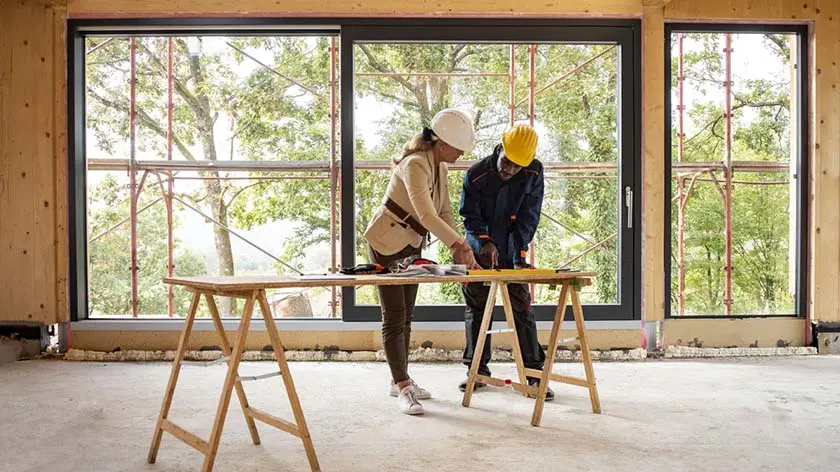
Your budget for building your own home should include a buffer for unexpected expenses.
At each milestone, the builder will take a “draw,” and the bank will evaluate the work done to that point.
When construction is completed, your construction loan will be automatically converted to a long-term mortgage loan.
If you’ve been thinking about moving to a new home but are having trouble finding your dream house in the current tight housing market, one option would be to build your own home.
There are a number of benefits to new construction vs. buying an existing home. For one thing, you can customize the home just the way you want instead of settling for an existing home that might not be exactly what you would choose.
Depending on the market, a brand-new home also might be worth more money than an older existing home. And many new homes include modern technology and security features that most older homes don’t have. New homes also tend to be more energy-efficient than older homes, which can lead to lower utility bills.
If you decide that you want to build a new home, it’s important to understand what it takes from a financial perspective, because financing new home construction is very different from the process of financing and buying an existing home.
The financial steps of building a home
1. Set your new home construction budget.
This is the first step when both building a new home or buying an existing home, but it’s especially important when building due to the financial commitment that’s involved, says Jenny Yuen, mortgage sales supervisor with U.S. Bank Wealth Management.
“When you go on vacation, you should have an idea of how much you can spend before you book flights, accommodation and other activities,” says Yuen. “It’s the same thing with building a home. You need to have a good idea of how much you can afford before breaking ground.”
Getting preapproved by a bank for a construction loan is step number one. “This will tell you how much money the bank is willing to lend toward construction of the home,” says Yuen. Once you know this, you can apply for financing and start working with an architect or builder to design a home that fits within your budget.
Be sure to build in a buffer, because it’s a rare construction project that is completed without a few unexpected costs along the way.
2. Choosing a new home builder.
You will work very closely with your builder for up to a year or longer, so perform the proper due diligence to help ensure that you make the right choice.
Yuen recommends interviewing at least two or three different builders before choosing one. “If a builder resists any of your ideas, this should be a major red flag,” she says. “You don’t want to have to find a new builder after construction has begun.”
3. Learn about the new home construction permit process and insurance requirements.
The permitting process is different from one county to the next, so research your county’s process and requirements. According to Yuen, it’s usually the builder’s responsibility to help clients understand permitting, including the timing and cost.
“At each milestone, the builder must draw up paperwork describing the work done so far and submit this to the bank, which will send out an inspector for confirmation.”
Jenny Yuen, mortgage sales supervisor, U.S. Bank Wealth Management
Meanwhile, your bank will usually work with you and your insurance agent to ensure sufficient coverage for the project. “The bank will usually require builder risk insurance to cover property liability during construction,” says Yuen. “Sometimes builders have this insurance and offer it to your, or you can obtain your own policy.”
4. Understand how funds are released to the builder during construction.
In most arrangements, builders take “draws” when certain construction milestones are reached. This begins with an initial draw at closing to start construction and ends when a certificate of occupancy (or CO) is issued for the home.
“Let’s say John and Jane are building a $1 million home,” Yuen says. “The builder might take a 10% draw—say, $100,000—at closing and then another 10% at the first milestone, which is laying the foundation. Framing might be the next milestone where the builder takes another 10% draw. At each milestone, the builder must draw up paperwork describing the work done so far and submit this to the bank, which will send out an inspector for confirmation.”
5. Understand how loan payments are made during construction.
Yuen compares a construction budget to a credit card in the sense that interest is only paid on the amount of money that’s borrowed. “Using John and Jane again as an example, they’ll pay interest on the first $100,000 draw and then on the $200,000 after the next draw is made,” she explains. The construction loan interest rate is locked in at closing.
6. Understand how the new construction loan is converted to a long-term mortgage once the home is finished.
Once construction is finished and a CO is issued, the construction loan will convert to a traditional fixed rate mortgage within 30 days. “This is done automatically,” says Yuen. “The borrower doesn’t have to reapply for another loan.”
Note that the build time is included in the loan amortization. So if it takes one year to build a home, this year is deducted from a 30-year mortgage, leaving 29 years on the loan. “That’s why I call this a unicorn mortgage,” says Yuen.
As with any financial decision, a solid foundation is critical. Whether it’s a new construction loan or a traditional mortgage, Yuen says U.S. Bank helps clients to better understand the financial steps to building a house from the ground up.
Learn more about customized loan options from U.S. Bank Wealth Management.
Explore more
Home sale proceeds: What to do with profit from house sale
Skyrocketing home prices are tempting homeowners to sell and capitalize on outsized value appreciation. But should you spend, save or invest the profits from selling your home?
Banking products and services personalized for you.
Access to dedicated bankers, customized financing options and exclusive benefits that support your personal and business banking needs.


